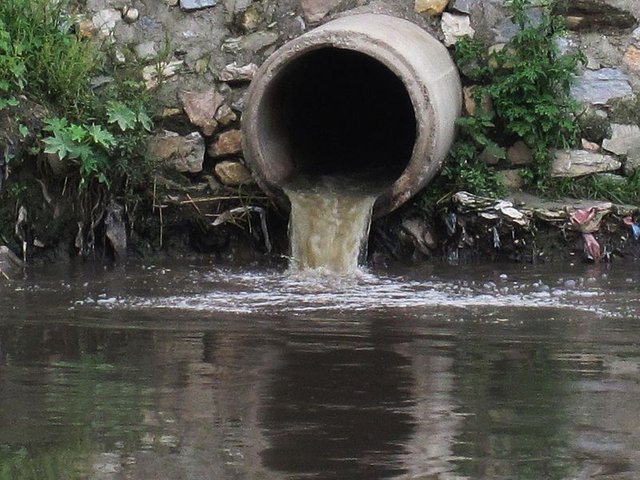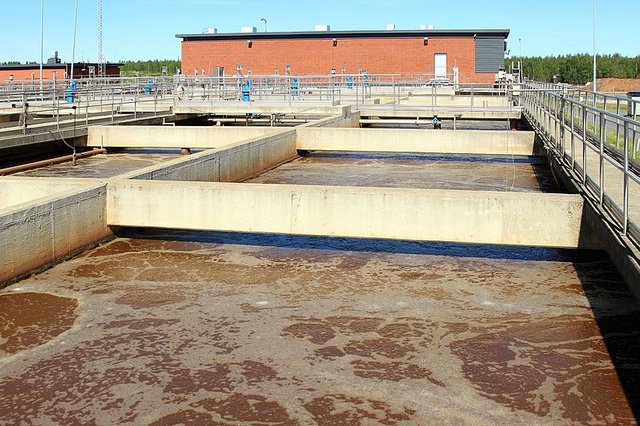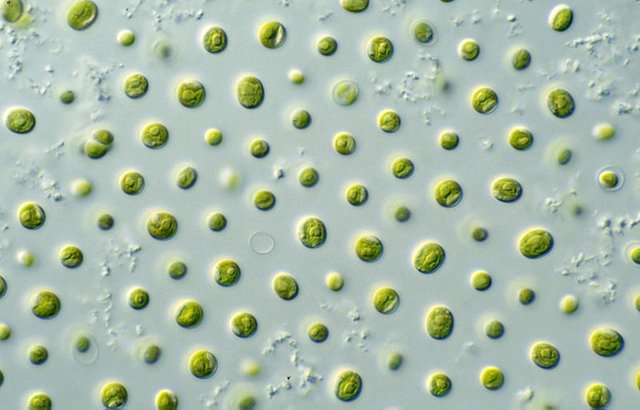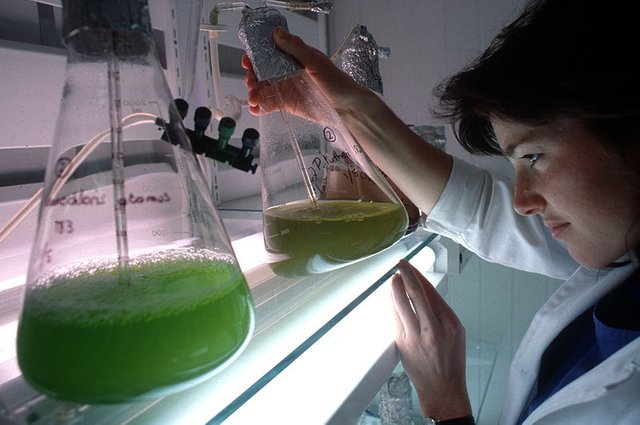While a large part of the world is concerned about the effects of climate change due to global warming, and summits are held between governments and organizations to discuss the issue, it goes almost unnoticed that more than 80% of the wastewater generated is discharged into lakes and seas without receiving any treatment, and that in addition, millions of people in the world have difficulty accessing water and lack basic sanitation services. This is an alarming situation that should also be high on the agenda.

Direct disposal of wastewater. Source: Wikimedia Commons.
Perhaps we trust in the high capacity of water bodies to assimilate pollutants, but this is not sustainable. In this regard, different designs of wastewater treatment plants have been explored to help massify their use, since conventional systems are very expensive, require chemicals and are not very efficient. In this sense, the use of microalgae is bursting into the world of water sanitation as a hopeful biotechnological alternative, since in their research and development phase they are proving to be very efficient, only sunlight is needed to purify the water and at the same time they transform pollutants into valuable compounds and capture CO2.
How a wastewater treatment plant works
Conventional wastewater treatment systems consist of at least three main stages:
Primary treatment: this is a treatment stage where coarse solids and solid particles carried by the water as it travels through the sewer are removed from the water, physical and mechanical separation processes such as roughing, decanting, desanding and oil and grease separation are used.
Secondary treatment: is based on the use of biological methods for the elimination of organic matter. Aerobic processes (in the presence of oxygen) and anaerobic processes (in the absence of oxygen) are used to promote the activity of certain bacteria that feed on the biodegradable organic substances present in the wastewater. Some of the most common processes in this stage are activated sludge reactors, oxidation lagoons and biodiscs, among others.
Tertiary treatment: these are based on chemical methods whose objective is the elimination of pathogenic agents for human health or the environment, such as the removal of heavy metals and infectious agents. For this purpose, methods such as microfiltration, ozonation and disinfection by ultraviolet light, to name a few, are used.

Image of a conventional treatment plant. Source: Wikimedia commons.
However, although these processes allow us to have treated water of sufficient quality to be reused in some processes or to discharge it safely into the environment, their implementation is scarce because they consume a lot of energy, require periodic maintenance and generate a lot of waste. Therefore, efforts have been made to advance more sustainable methods that can be integrated into a circular economy strategy.
Microalgae
In this sense, microalgae can enter the process and directly replace secondary and tertiary treatments, and are capable of absorbing carbon, reducing energy expenditure and producing valuable compounds.

Microalgae – Nannochloropsis sp. Source: Wikimedia commons.
Microalgae are microscopic plants that feed on carbon (from CO2) nitrogen (from nitrates), phosphorus (from phosphates); for this reason we may have read or seen that they multiply uncontrollably in polluted water bodies, and that is why the water in these reservoirs looks green. That is to say, they not only eliminate these pollutants from wastewater but also produce a large amount of biomass rich in these elements, which can then be used as ecological fertilizers.
On the other hand, they do not require energy since they only need sunlight or injecting oxygen as in other biological processes, since they extract it from the water by themselves.
For this reason, their use has been proposed in treatment plants to save energy, capture carbon and generate valuable bioproducts instead of just waste. They are therefore a better alternative than the use of landfills.
Many water-stressed regions are considering water reuse, so we need to develop and improve tertiary purification methods and ensure better quality water for their use. And microalgae have already been shown to remove 95% of pollutants such as carbon, nitrogen and phosphorus, as well as being effective in eliminating certain pathogens and emerging pollutants, saving up to 40% of energy costs.

Microalgae research. Source: Wikimedia commons.
Although development stages and further research are still lacking, microalgae look promising for integrated water management and contribute to the achievement of the UN Sustainable Development Goal: Ensure availability and sustainable management of water and sanitation for all.
Thanks for coming by to read friends, I hope you liked the information. See you next time.
References
Wearewater.org. Microalgas: biotecnología para el saneamiento universal.
Aguasresiduales.info. Tecnologías de microalgas; una propuesta sostenible para el tratamiento de aguas residuales industriales en ACERINOX.
UN.org Objetivo 6: Garantizar la disponibilidad de agua y su gestión sostenible y el saneamiento para todos.

Hello friend.
Very important information you share and it is very good to know that microalgae remove 95% of pollutants such as carbon, nitrogen and phosphorus, which can lead to eliminate part of pathogenic animals and pollutants, besides it would help us to reduce wastewater pollutants.
Greetings friend
Downvoting a post can decrease pending rewards and make it less visible. Common reasons:
Submit
Greetings friend. They seem to be proving to be quite effective in the elimination of contaminants, and have the advantage of reducing energy consumption, no doubt they will be an important alternative in the treatment of wastewater.
Downvoting a post can decrease pending rewards and make it less visible. Common reasons:
Submit
Greetings @ emiliomoron
Thank you very much for sharing very relevant information about the environment and wastewater pollution.
I highlight these lines where you state "Microalgae are microscopic plants that feed on carbon (from CO 2 ), nitrogen (from nitrates), phosphorus (from phosphates); for this reason we may have read or seen that they multiply uncontrollably in polluted water bodies, and that is why the water in these reservoirs looks green. In other words, they not only remove these pollutants from wastewater but also produce a large amount of biomass rich in these elements, which can then be used as green fertilizers." I particularly had a misconception of those algae , but now I know that they fulfill a fundamental function to improve water quality that can also be used as fertilizer for crops.
Thank you very much for sharing
Downvoting a post can decrease pending rewards and make it less visible. Common reasons:
Submit
Greetings my friend @dgalan. The truth is that many of us think this way, we mistakenly believe that the problem is algae, when the problem is water pollution, whose concentration of the compounds on which they feed makes their population increase uncontrollably. Although this can be used to purify the water and obtain biomass.
Downvoting a post can decrease pending rewards and make it less visible. Common reasons:
Submit
Hi @emiliomoron
Fortunately, there is this option of microalgae as a sustainable and profitable alternative to solve a serious problem that we face as humanity.
Excellent article as always, thank you for sharing.
Have a gread a day!
Warmest regards.
Downvoting a post can decrease pending rewards and make it less visible. Common reasons:
Submit
Hi @janettyanez, thank you very much for stopping by to read. It is really emerging as a good alternative, I have always been a supporter of biological processes, and this looks like a very good alternative.
Downvoting a post can decrease pending rewards and make it less visible. Common reasons:
Submit
Many people are really suffering from lack of water and water recycling will help them alot. Since microalgae is still under development am sure very soon it will be adopted everywhere but my question is that since it need sunlight during raining season that some days are without sun does it mean water purification will not be able to take place?
Downvoting a post can decrease pending rewards and make it less visible. Common reasons:
Submit
Greetings @jennyvic09, thanks for commenting. There are several factors that must be evaluated, and that is an important aspect, from what I could review even the depth of the pond influences, because the deeper it is the less light will arrive, so the immediate solution is to occupy more surface area to capture more light, perhaps in periods of rain the performance decreases, but still there will be a percentage of light with which the process continues.
Downvoting a post can decrease pending rewards and make it less visible. Common reasons:
Submit
Okay, thanks for answering my question.
Downvoting a post can decrease pending rewards and make it less visible. Common reasons:
Submit